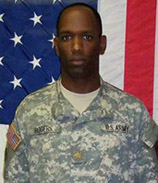Who was Alan Rogers?

Army Major Alan Rogers.
Courtesy Department of Defense
Details of the biographical sketch were relatively easy to fill in. Alan Rogers was born in New York City in 1967. When he was three, Alan was adopted by George and Genevieve Rogers, a devout, working‐class African‐American family from the South Bronx. His family moved to Florida when he was nine. After high school, Rogers attended a local community college before enlisting in the Army. Rogers deployed for his first tour of combat duty in December 1990 as a chaplain’s assistant in the first Gulf War.
On his return to the US Rogers, with the help of an ROTC scholarship, enrolled at the University of Florida. There he met Shay Hill, who became his close friend and roommate. Rogers graduated in 1995 with a bachelor’s degree in theology, and was ordained a Baptist minister through his local church. The same year, he accepted a commission from the Army and, while stationed in Arizona, earned a master’s degree in organizational management at the University of Phoenix before going on to serve in South Korea.
Throughout his life, Rogers seemed to excel both as a soldier and a scholar. When his first tour in the Iraq War was over, in 2004, he was chosen as part of an elite group of Army officers to participate in a two-year program that included a public policy master’s (his second graduate degree) at Georgetown University, as well as a prestigious internship at the Joint Chiefs of Staff. After graduating, Rogers was eventually hired as the lead biometrics officer in Army Intelligence, working on cutting‐edge, sensitive biometric technology used for counterinsurgency warfare. The sector was rife with politics and notoriously hard to manage, but Rogers’ calm, measured intellect was in demand, and he became a highly valued member of the team.
Untangling the details of Rogers’ personal life was more challenging. Soon after his 2004 move to Washington, DC, Rogers joined AVER. Within six months of joining, Rogers was elected treasurer and membership coordinator. He seemed to have been active in the city’s gay scene. But though Rogers had scores of close friends, he led a compartmentalized life. He did not often speak of his love life and he had, as Alexander puts it, “pockets of friends”; many of Rogers’ friends did not know each other or of each other’s existence. Rogers’ Defense Department colleagues, even those with whom he was friendly, for example, did not know that he was gay.
Rogers’ Georgetown thesis presented another problem. His gay friends invoked the thesis, which dealt with the “don’t ask, don’t tell” policy, as proof of Rogers’ openness. But because it was technically a capstone paper and not a thesis, it had not been kept on file and St. George could not locate a copy of it. When she reached Professor Nadel, Rogers’ adviser, he told her that the paper was about the effect of the “don’t ask, don’t tell” policy on the Army’s recruitment and retention rates, not on whether the policy was justified. St. George tried to gauge whether the thesis did in fact suggest Rogers’ openness by asking Nadel if Rogers had been especially passionate about the topic. Nadel said that he hadn’t been. [1]
Rogers redeployed to Iraq in late 2007. Stationed in Baghdad, he was embedded with a unit of Iraqi soldiers whose training he supervised. On January 27, 2008, Rogers was out on a morning patrol when his Humvee drove past a guardrail rigged with an IED (Improvised Explosive Device). Rogers, 40, was killed on the spot. [2] He was two weeks away from going home on leave to stand as best man at Hill’s wedding. “As God would have it,” his commanding officer wrote to his family in a letter, “he shielded two men who probably would have been killed if Alan had not been there.” [3]
But while the biography was fairly easy to write, St. George was still unresolved about the question of Rogers’ sexual orientation. Should she identify Rogers as gay?
[1] Author’s interview with Mark V. Nadel, October 15, 2008, in New York, NY. All further quotes from Nadel, unless otherwise attributed, are from this interview.
[2] “It’s pretty unusual for someone of that rank to get killed,” says Nadel of students in the Master of Policy Management Program at Georgetown. “By the time they redeploy to Iraq, most of them are majors. That’s a pretty high rank and so they’re not typically on patrol. [Rogers] was, unfortunately.” As of spring 2008, Rogers was the first and only graduate of the program to be killed in action.
[3] Donna St. George, “Army Officer Remembered As Hero.”